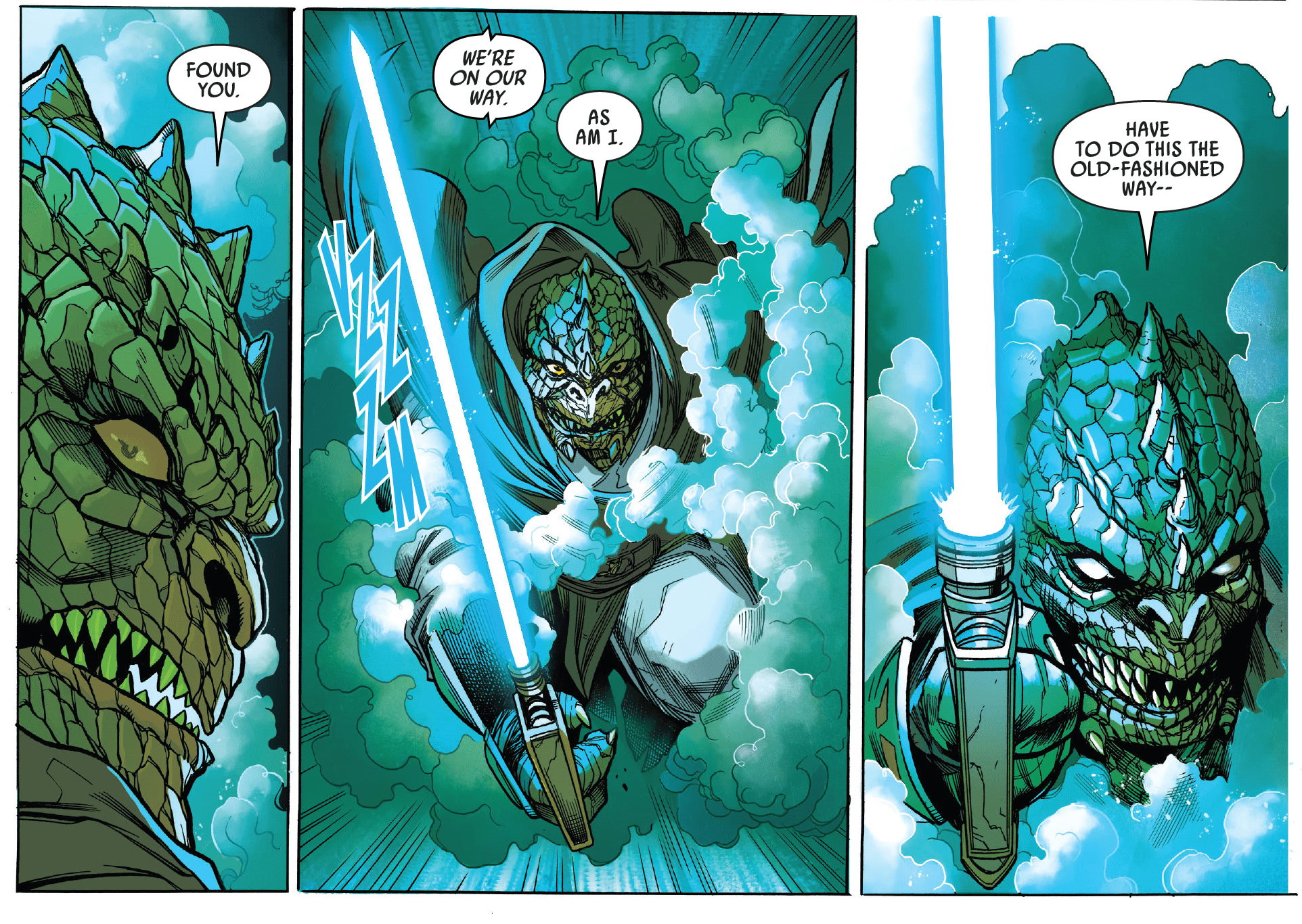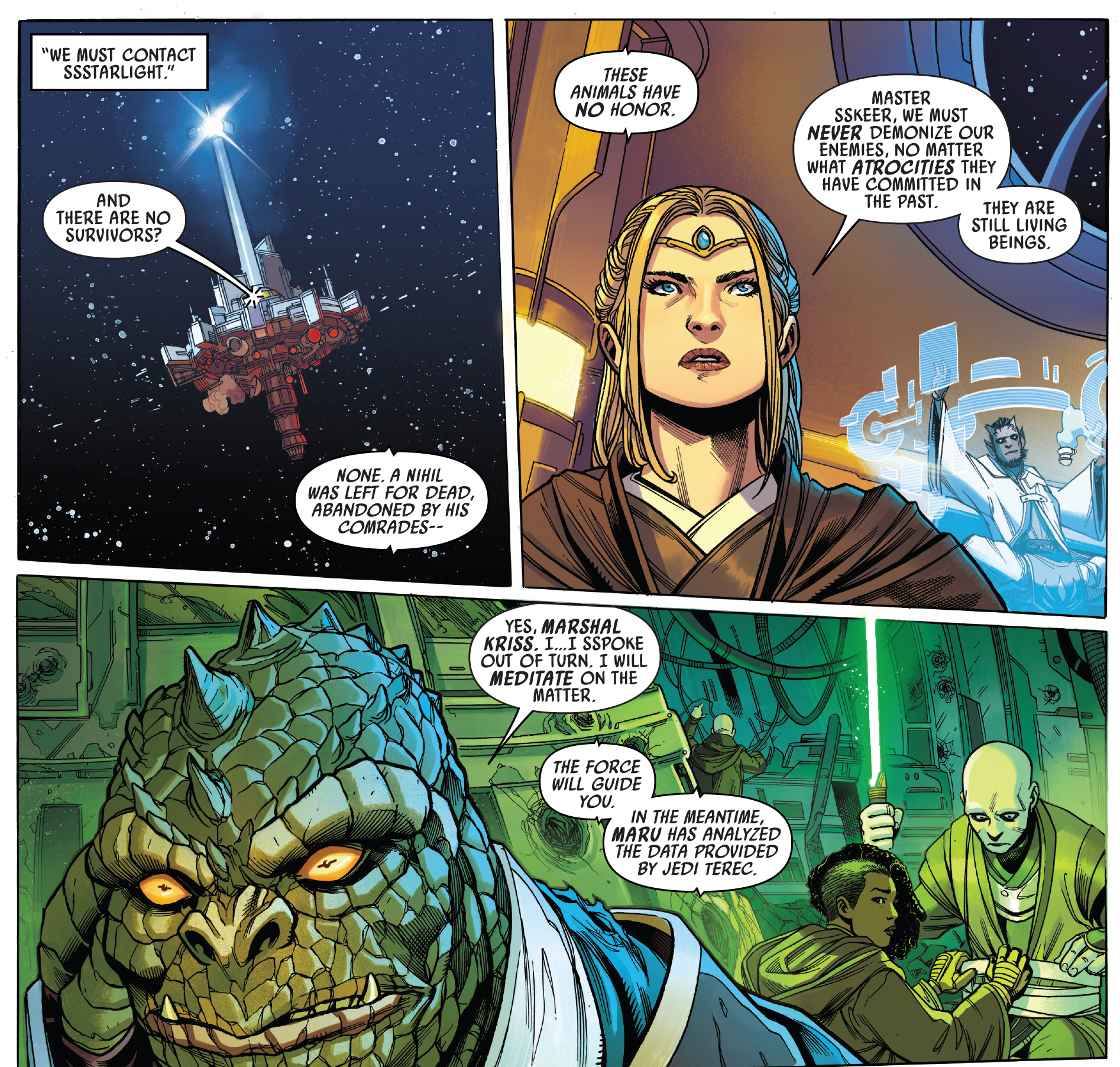One of the more interesting things about Star Wars: The High Republic’s cast of blindingly light goody-two-shoe Jedi is the layers through which their confidence in the Force and their grasp of it for good is presented. But few are as interesting as perhaps one of the most unexpected Jedi Masters of all: your lizard boyfriend and mine, Master Sskeer.
The Trandoshan ex-Master to Keeve Trennis, the main Jedi protagonist of Marvel’s Star Wars: The High Republic comic by Cavan Scott, Ario Anindito, Mark Morales, Annalisa Leoni, and Ariana Maher, Sskeer has slowly come to the fore over Charles Soule’s Light of the Jedi and the early issues of the Marvel series. Brutally wounded in the climax of Light during a battle with the Nihil, Sskeer enters the scene in the Marvel book as a man confronting a sense of traumatic loss: spiritually, as he lets go of his Padawan Keeve when she becomes a young Jedi Knight, and physically and emotionally as he grasps with the lingering trauma of having his left arm shorn off in a starfighter collision.
Since he’s a Trandoshan, it’s not permanent: his limb will regrow with time, and Sskeer does not let its absence get in the way of his business as a Jedi. But this week’s Star Wars: The High Republic #2 shows that, for all his external stoicism, the Jedi has a lot more emotional roiling under the surface than we’d typically expect of a Master of the Jedi Order, at least by the haughtily conservative standards we’ve seen in the Star Wars prequels. And they’re not all necessarily related to his arm, in some pretty fascinating ways.

With the events of Light of the Jedi behind us in earnest, Star Wars: The High Republic #2 quickly sets Keeve and Sskeer (and the intriguing Jedi Terec and Ceret, Kotabi bond-twins who share a linked mind) on the task of investigating more smash-and-grab attacks by the Nihil on the fringes of Republic space. Pretty quickly, our investigators come across an abandoned space hulk littered with the corpses and ruins of a Nihil attack aftermath. But it’s not quite as over as Keeve and her colleagues believe it to be as they go about exploring the derelict. While Keeve uncovers that the ship contained harvests used in the development of the (still relatively new technology at this point in the timeline) medicinal supply Bacta, Sskeer and Terec find themselves ambushed by a remaining Nihil sniper, wounding the bond-twin.

Immediately, something about Sskeer changes. Desperate to find their hidden assailant, he hunches over, his eyes switch to an empty, pale yellow, and declares that it’s time to take the offensive the old fashioned way — like his Trandoshan ancestors. What follows is unlike anything we’ve ever expected out of a Jedi Master before: Sskeer becomes this primal, angry force of nature, stalking his Nihil foe before violently — shockingly violently — dispatching them. He doesn’t even stop there, caught up in this frenzy of hunting lust and lingering trauma from the loss of his arm, he hacks away at the Nihil corpse with his lightsaber until Keeve’s arrival on the scene rouses him from his fury.
Despite appearances, Sskeer’s actions don’t see Keeve raise her own lightsaber against her former master and declare him lost to the Dark Side. She’s shocked at the violent, decidedly undiplomatic end to their foe, yes, but she doesn’t immediately fear the worst of her master. Neither does Avar Kriss back at Starlight Beacon when Keeve tells her of Sskeer’s lapse. In fact, she almost expects this in him: a Trandoshan who has strived for balance between the instinctual fury of his people and the serenity of the Light side, defied expectations, to become a Jedi Master. Sometimes that balance necessitates Sskeer dipping into his anger, tempered with the fact he must also be mindful to rouse himself from it, and distance himself from it.

After dispatching Sskeer on a follow-up mission without Keeve, she eventually acknowledges that this was maybe not the best idea — that between his anger over the Nihil and his trauma over losing his arm, Sskeer needs time to step back and gain some perspective instead of pushing himself further into these dark aspects of himself. But she does not pin that failure of realisation on Sskeer for leveraging those impulses in the first place, nor does she dismiss him as a Jedi for being Trandoshan — a species Star Wars has mostly asked us to see as slavers, pirates, bounty hunters, and generally awful people — and having those hunter instincts in the first place. It speaks to a more enlightened understanding of the Force that these Jedi in this renaissance era have: the openness to accept people from all species regardless of reputation, to be able to acknowledge that even the best Jedi are still people with struggles and aspects of the Light and Dark Side within them. That balance, not rejection or demonisation of darkness, makes for a better relationship with the Force.
Of course, this is far from the first time we’ve seen the concept of a Jedi being able to understand at least some form of the kind of emotions and inhibitions we would typically associate with the Dark Side of the Force and still be seen as a well-studied paragon of the Light. In the old Expanded Universe, it was explained that Kel Dor Jedi Master Plo Koon could summon Force Lightning. It’s a power inextricably linked in our minds as an act of the Dark Side but he was in fact studying a form of it where its power is derived from a stance of noble justice rather than anger. Mace Windu, meanwhile, was a master of the Vapaad lightsaber form, a school of combat built around channeling latent, dark impulses into a ferocious flurry of blows — his expertise as one of the few Jedi to embrace the form without falling to the Dark Side showing the strength of his ability to achieve balance.

But what makes Sskeer feel different here is how his nature as a Trandoshan and the wider acceptance of the Jedi to his use and control of anger speaks to a higher sense of acceptance and understanding of the different paths to the Light a Jedi could take. The Jedi Order we’ve met so far in The High Republic seem to be defined by this more open and accepting nature: that their position as the zenith of the Order’s power and reach is drawn not from simple mastery of the Force or martial prowess, but instead their willingness to bend and adapt doctrine when presented with alternate paths to the road of peace and justice.
Sskeer’s path right now might be pushing towards troublesome, but so far, it’s fascinating to see his friends not view it as an immediate indicator that he has fallen to a worse nature, or become one with the Dark — but that instead, he needs to be helped to strive balance and not hide part of who he is in his whole as a Jedi.
A more civilised age, indeed.
